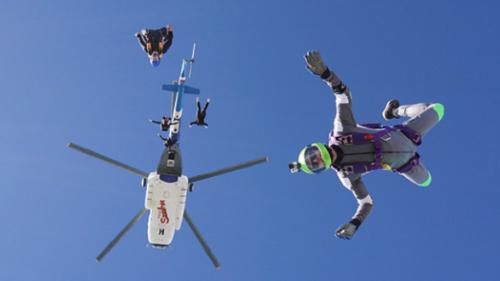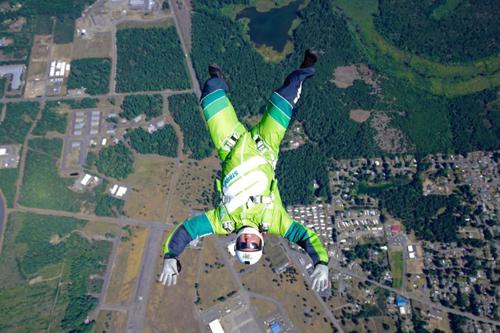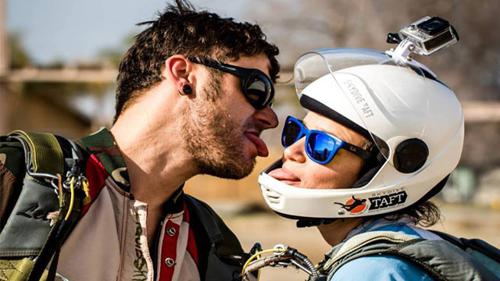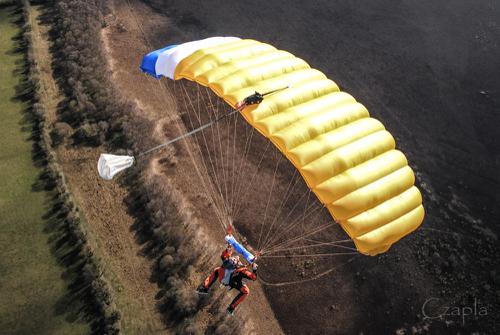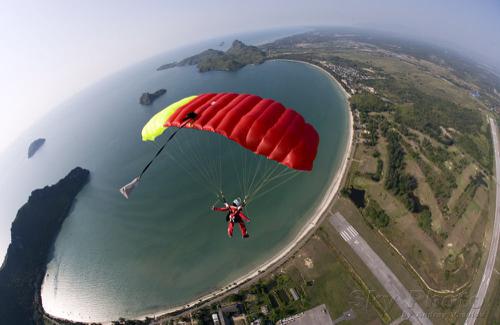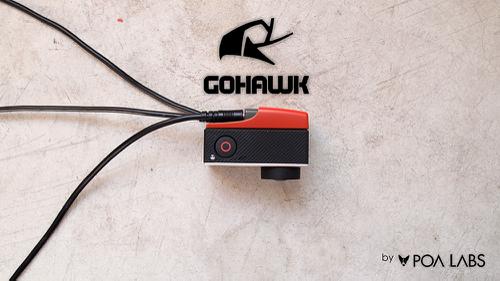Meet the Forces of Nature That Turn Your Loads
Originally published 2014. Postscript follows.
Dan McNulty - Skydive the Wasatch
When I call, it’s 7:00 p.m. for me. It’s 6:30 a.m. in Afghanistan, where Dan McNulty is talking to me (presumably, with a big mug of coffee in-hand).
Dan’s about to become the proud owner of a brand-new drop zone in Nephi, Utah – a quiet little one-horse town about an hour south of Salt Lake City along highway 15. The airfield is sized just-right for the easy-going, mom-and-pop affair Dan envisons: four tidy hangers, a well-maintained runway and acres of green grass for soft landings. Mt. Nebo, the highest point in the entire Wasatch and the snow capped centerpiece of the southern range, rises to a majestic 11,928 feet just alongside. Dan closes on his hangar next week. He’s stoked.
He’s never actually seen the airfield, but that doesn’t bother him a bit. He’s already named it, even: Skydive the Wasatch, naturally.
The season starts the second week in April. He gets home from Afghanistan March 26th.
In just weeks, then, he’ll be adding a three-letter acronym to his name that only a few hundred other humans can claim: “DZO” – Drop zone Owner.
Skydive the Wasatch didn’t happen overnight. Dan’s been working on this for almost two years – almost entirely remotely, patching it all together with emails and phone calls. Seeing little growth on the horizon of his current job as a security contractor in Afghanistan and being very familiar with the skydiving industry, he decided that opening a drop zone was, in his words, a “natural progression.”
After an abortive attempt to set up shop on an airfield in the Heber Valley, which ended up effectively denying skydiving access with a combination of prohibitive policies and price-outs, Dan discovered the pretty little airfield in the placidly agrarian town of Nephi.
“It turns out that Nephi is perfect,” Dan says. “It has everything we need. It’s close to Salt Lake City and Provo. And the city is really excited for skydiving to come to town, which is really rare and really important.” When the papers were signed, Skydive the Wasatch was effectively born (though it won’t be open for business until springtime).
Dan McNaulty
To run a skydiving operation, you need a plane. Working from Afghanistan, Dan sourced an aircraft from Skydive New Mexico, a DZ with – uniquely – the same altitude as Nephi, 5,000 feet ASL. He knows, then, that this particular souped-up Cessna 182 can do the same trick for him as it did for them: climb 11,500 feet in a crisp 20 minutes. The pilot is a Moab expat with a few hundred hours flying skydivers at Skydive Canyon lands, another high-altitude drop zone.
“We’re starting streamlined,” Dan says. “The basics. We’ll build as we grow. And we do intend to grow.”
John Hamilton - Skydive Elsinore
John Hamilton, the owner and General Manager of Skydive Elsinore, knows all about growth.
Though Skydive Elsinore has been an operating drop zone since 1959, the landscape of the sport has changed almost unrecognizable since he bought Skydive Elsinore with business partner Karl Gulledge. Since then, “Elsi” has burgeoned from its previous status as a small-but-historic airfield to one of the largest, highest-grossing drop zones in the world. To date, Skydive Elsinore hasn’t just hucked hundreds of thousands of skydivers over the rolling landscape aside the soaring Ortega mountain range. It has been a key partner to the advancement of parachuting technology and aerospace at large, hosting scientific studies for JPL, Pioneer Aerospace, Airborne Systems, Vertigo Inc., JSAF, Cirrus Aircraft Recovery Systems and a great many of the world’s elite air force parachuting groups.
“When I first became a DZO, big surprises were a daily occurrence,” John remembers. “I guess in the beginning I can look back and say that ignorance was a form of bliss.” He laughs. “I don’t know if I ever would have taken on the challenges that awaited me if I really knew what I was getting into.”
Part of John’s blissful ignorance was that he was about to become an unwilling expert in the formation of companies, legal issues, governmental regulations, employment challenges, marketing, accounting, customer service, budgeting, banking regulations, web development, social marketing, online community-building, search engine optimization and a long list of other non-skydiving-related subjects. He also had a crash course in effective communication, which he hails as the most valuable weapon in his DZO arsenal.
“At the beginning, I felt like I was eating an elephant, one small nibble at a time,” he says, his smile wry.
John’s relationship with skydiving has evolved from a “pure passion for the sport” to a round-the-clock focus on the business. He admits to sometimes losing sight of that original passion – he was a BASE jumper and a competitive 4-way skydiver, after all – in the thick tangle of ownership responsibilities. As he relates them, he peeks out toward the sky, a grin suddenly playing at the corners of his mouth.
“You have to keep the balance. When I get lost in all this, the plane is right outside my office. I can always make a sunset load. It does the trick.”
John Hamilton
While skydiving remained relatively predictable in its equipment and disciplines for many years at the beginning of John’s tenure, the pace has picked up significantly. “In today’s skydiving industry, challenges arrive almost overnight,” he asserts, “And they change just as fast.” Modern DZOs must constantly adapt to the logistical, safety and economic challenges posed by the sport’s ever-changing pantheon of disciplines.
“With the advent of horizontal flight – wingsuiting, tracking, angle flying, etcetera – we have had the challenge of integrating a whole list of new safety policies, while at the same time working with the governmental agencies who govern our sport.”
“The feedback from our jumpers varies widely,” he continues, “and much of it makes me think that the vast proportion of jumpers don’t understand the hard work we must do in order for them to enjoy these new methods and technologies. It’s about so much more than the sum of its parts, and jumper cooperation is key, but I am ultimately responsible for the safety conducted on the drop zone.”
John refuses to create an atmosphere that influences younger jumpers to push their own abilities too far. He’s known for his tireless encouragement of Elsinore’s instructional staff – and experienced jumpers, too – to lead by example, even as the community undergoes exponential growth.
“I understand the thrill for newer skydivers to want to push the limits of disciplines in the sport. Trust me, I do. But it’s important for those jumpers to understand that keeping a safe culture lets us all continue to skydive.”
Elsinore’s track record, for the number of jumps made here, is stellar. However, it’s a numbers game – and it doesn’t always work.
“The biggest headaches of my job are, almost without exception, those that stem around the many legal risks and challenges associated with running a skydiving center – the intersection of personal responsibility and DZ responsibility, for the most part.” John pauses. “For example: a student will turn themselves into the ground, then will doggedly challenge the waiver and try to find blame in everyone else, without taking any responsibility for their own actions.”
“It’s challenging, yeah. It can be a Herculean undertaking.” He pauses. “However – I get to see people’s faces after they land from that first tandem skydive. I get to know that I was part of that life-changing event for every one of them. It brings a huge smile to my face, every time. I get to help the next generation of skydivers grow as athletes and as people. It is absolutely worth it.”
In passing, I tell John about Dan McNulty and his new drop zone in Nephi. John leans in.
“Here’s what I’ve learned from my experience: Find a good lawyer. Then find a good accountant,” he says. “Also: It may seem unnecessary – counterproductive, even – but do things by the book in all cases. You may think you’re saving money, or even making money, by doing one or two things in the proverbial grey area. You’re not. Trust me.”
He continues. “Learn to accept the rule of thirds: one-third of the people you deal with will like you, another third will tolerate you – and the last third won’t like you one bit. That doesn’t matter.” He takes a level breath. “When you’re dealing with a difficult situation, forget about public opinion and ask yourself the following before you communicate a response: am I doing this because it’s the right thing to do, or because I want to prove myself right? The answer is almost always obvious.”
Lelo Mraz & Claudia Blank - Skydive Taft
It’s unsurprising that John inspired others to follow a similar path: specifically, two good-looking Brazilian kids with megawatt smiles.
Lelo Mraz and Claudia Blank have been beloved members of the Southern California skydiving world for a couple of decades. Recently, they joined business partner Michael Choi to become the proud new owners of their own facility: Skydive Taft.
Lelo and Claudia arrived in Redondo Beach in the early 2000s from different small towns in their shared native country, and promptly fell in love. Lelo had started jumping seriously in Brazil back in 1995; he’d logged hundreds of hours in the Perris sky and tunnel by the time the two showed up to Elsinore as a pair. Claudia, on the other hand, hadn’t made so much as a tandem. Suddenly, in 2008, she decided offhand to do a jump. Naturally, Lelo ran outside video. By 2009, Claudia was an inveterate skydiver and, like Lelo, had a full-time job at the Skydive Elsinore DZ.
The pair loved their jobs. They loved the Elsi community. They loved the skydiving. But they’re also clever, enthusiastic folks who love a challenge, and Lelo knew they couldn’t stay there forever.
“I came up with the drop zone idea a couple of years ago,” Lelo remembers. “I’ve always known that I wanted my own business, and I know skydiving really well, so I was kicking around business plans, trying to come up with numbers that would be workable.”
“I first looked into wind tunnels, but the investment is around ten million dollars. When I started to investigate drop zones, the money part started to make sense.”
He started talking to mentors: not just John Hammond, Karl and Laurent “Lob” Lobjoit from Elsinore, but Rich Greene from Oceanside, as well as other pros who had walked the mine-strewn path before him.
Lelo Mraz & Claudia Blank
It took time, of course.
“I spent a lot of time looking into airfields around California – we love California, and definitely didn’t want to leave. Nothing seemed to work, though. Then one day I was joking with my partner, Michael Choi, that maybe we should go check out Taft – even though it’s in the middle of nowhere – and that day, I saw an ad that it was for sale. It seemed like it was meant to be.”
From there, things moved quickly. There were signatures on the paperwork by last October, and the new crew took over the DZ on November first.
The Taft airfield is surprisingly big for its slightly out-of-the-way location. It has several hangars, a paved runway, two parking lots, a huge landing area and plenty of room for an active community of jumpers to settle in. So far, the pair is strategically running a small plane and slowly, thoughtfully rolling out a master plan for the DZ to be a regional center for training, rigging, courses and ratings.
It’s no easy task for young entrepreneurs – especially, for longtime members of the skydiving community – to take over a dropzone that’s been operating for as many years as Skydive Taft. Over the facility’s 24-year history, it had accrued a small-but-very-loyal following of fun jumpers who hadn’t seen much in the way of change before Lelo and Claudia appeared smilingly in the office. Ever.
“Most people like us, and we try hard to be fair, but we had to implement some policies that we felt to be extremely important from a safety standpoint,” Claudia explains. “A lot of the people who have been at Taft for so many years feel like it's their drop zone – like they own it. We don’t want to lose them, but some people get angry if we even move a couch.”
She continues, “We decided to make changes little by little, taking a more careful approach than we thought we’d have to take.” Claudia gives a wry smile. “So far, so good. But it isn’t easy.”
Leaving the tight community at Elsinore, too, was a struggle – and remains so, as the move is still fresh.
“I can honestly say that I had no complaints at all about our ‘old life’ in Elsinore,” Claudia muses. “It was so hard to completely walk away from what was already a dream job. I made money on the weekends and jumped for fun on the weekdays at one of the most beautiful DZs in the world. I loved it, and I loved my coworkers.”
“I was in denial until we finally had the paperwork,” she continues, “I knew that as soon as I made it official and quit, there was no turning back, even though they made sure to tell us that the door would always be open. This process – it changes something inside of you.”
The Elsinore team threw Lelo and Claudia a huge, very-well-attended farewell party, popping up with little surprises all day long, paying for as many jumps as the couple wanted to do and dedicating one of the drop zone’s signature paving tiles to them as a memento of their long service. There were tears.
It’s hard to spend time in nostalgia, however, when you have so much on your plate. For example, the first big boogie for the new drop zone is just around the corner: the Cal City Reunion, on March 22nd. Taft is sporting a bigger plane for the event and getting ready to welcome its biggest-ever crowds.
“For now, we're really new. We have a lot to learn. We have been going with the flow, but being very strategic with funding. We're not going into debt; we're working with savings. It was a leap of faith, but now – even though it’s winter – business is picking up, and money is coming in, so we feel OK.”
Meanwhile, in Afghanistan, Dan McNulty is working on the final details of the Skydive the Wasatch process. The tandem rigs are already bought and inspected,
Today’s checklist includes arranging for delivery of the plane and closing on the hangar.
“This has been a very creative process, so far,” Dan notes. “When I set out to do this, I was sure about one thing – that I'd never work for anyone else, ever again. It means that I am 100 percent responsible, for better or for worse. But it means that everything I do means something.
John Hammond seconds the sentiment. “Just when I think I’ve seen it all,” he laughs, “I am quickly reminded that I haven’t. Each and every day I run this dropzone brings new people, new challenges and new surprises.”
There is, clearly, an art to DZOing.
-----------
Postscript: In the seasons since this article’s first publication, both Skydive the Wasatch and Taft have, predictably, thrived. Claudia and Lelo are hosting the full-on Liquid Sky Free fall Fest in August. Dan McNulty has even picked up another drop zone: Piedmont Skydiving, in North Carolina.
Go jump with these guys and give ‘em a high-five!

